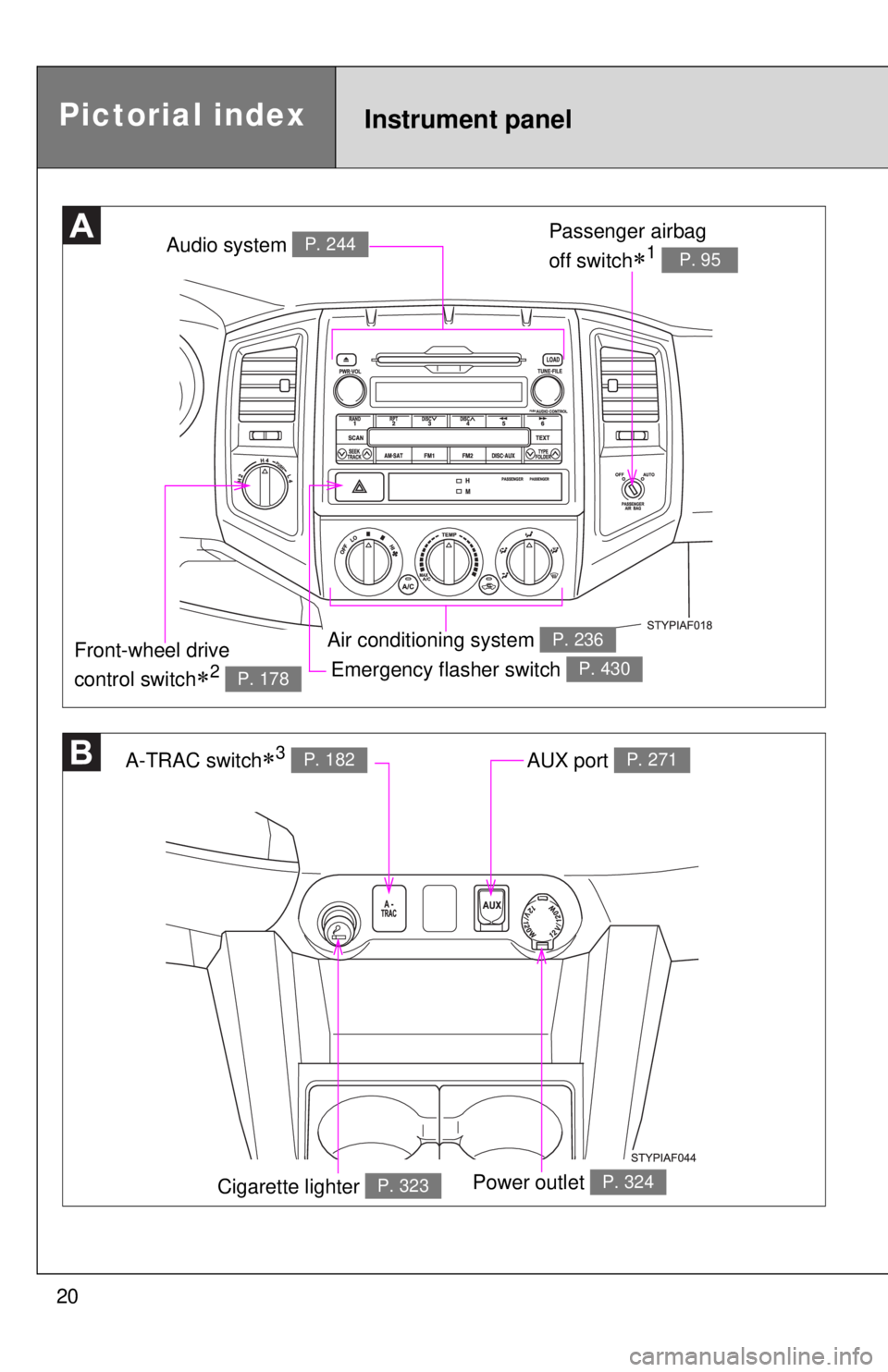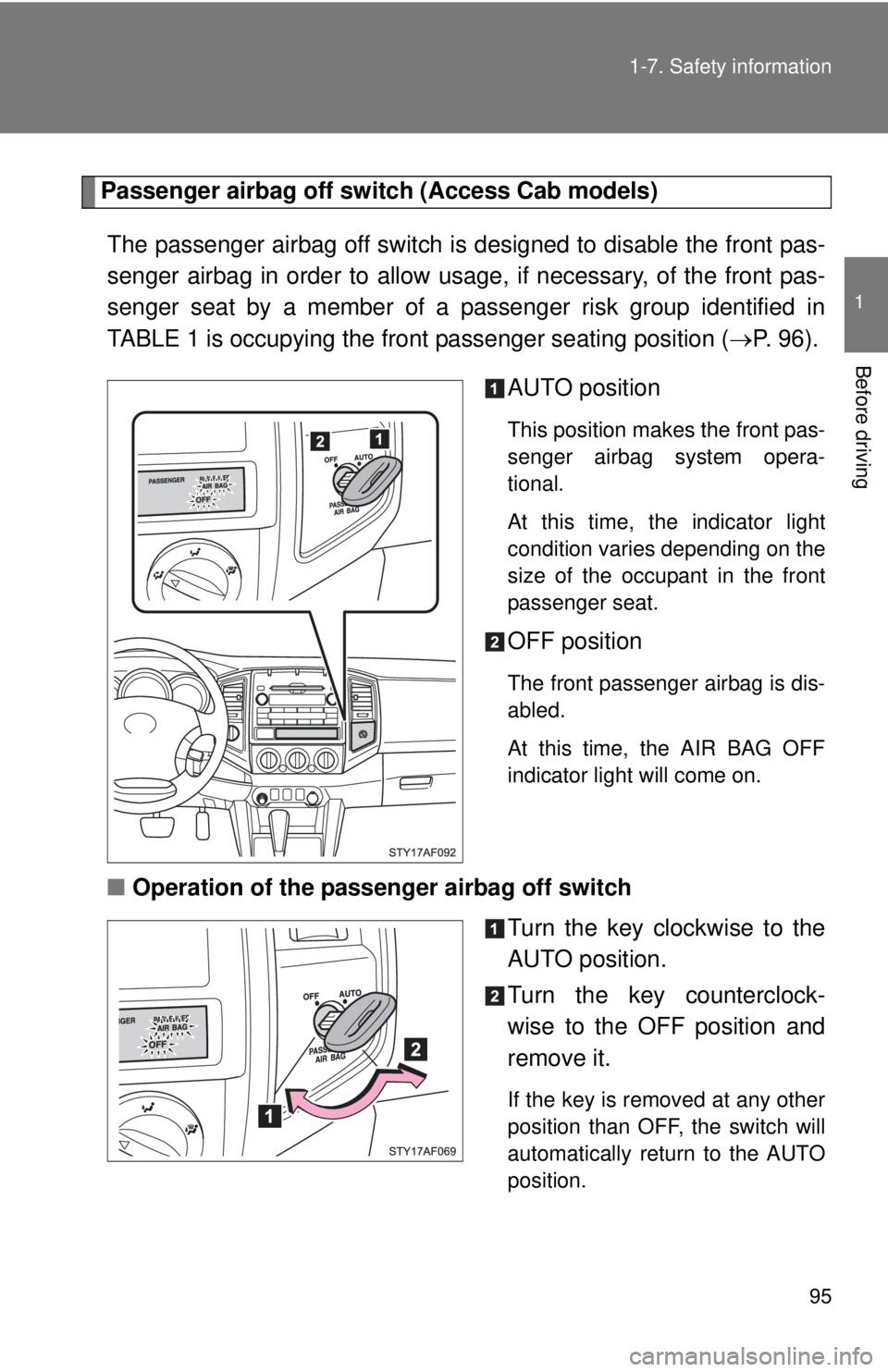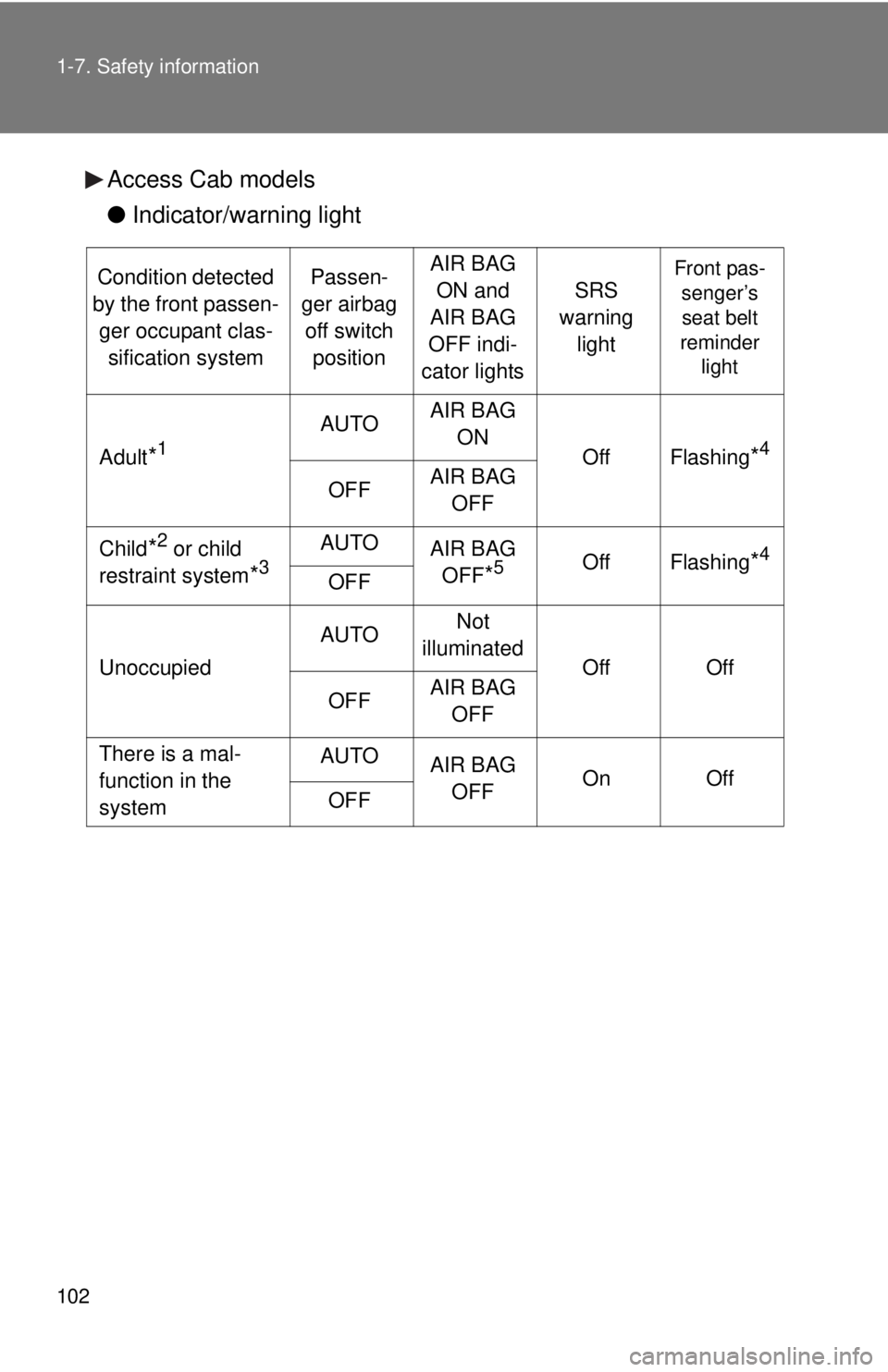airbag off TOYOTA TACOMA 2011 Owners Manual (in English)
[x] Cancel search | Manufacturer: TOYOTA, Model Year: 2011, Model line: TACOMA, Model: TOYOTA TACOMA 2011Pages: 548, PDF Size: 9.86 MB
Page 20 of 548

20
Emergency flasher switch P. 430
Audio system P. 244
Air conditioning system P. 236
A-TRAC switch3 P. 182AUX port P. 271
Power outlet P. 324
Passenger airbag
off switch
1 P. 95
Front-wheel drive
control switch
2 P. 178
Cigarette lighter P. 323
Pictorial indexInstrument panel
Page 84 of 548

84 1-7. Safety information
Your vehicle is equipped with ADVANCED AIRBAGS designed based
on US motor vehicle safety standards (FMVSS208). The airbag sys-
tem controls airbag deployment power for the driver and right front
passenger. The driver airbag system consists of the driver seat’s
position sensor etc. The front pass enger’s airbag system consists of
the front passenger occupant classification sensor etc.
The main SRS airbag system components are shown above. The
SRS airbag system is controlled by the airbag sensor assembly. The
airbag sensor assembly consists of a safing sensor and an airbag
sensor.
Bench type front seat: The SRS airb ags are designed to protect the
driver and right front passenger, and they are not designed to protect
an occupant in the front center seating position. Front passenger airbag
Curtain shield airbags
Side airbags
AIR BAG ON and AIR BAG
OFF indicator lights
SRS warning light and
RSCA OFF indicator light
Driver airbag
RSCA OFF switch
(4WD models only)
Curtain shield airbag sen-
sors (Access Cab and Dou-
ble Cab models)
Side and curtain shield air-
bag sensors
Driver’s seat position sen-
sor
Driver’s seat belt buckle
switch
Front passenger’s seat belt
buckle switch
Occupant detection system
(ECU and sensors)
Airbag sensor assembly
Front airbag sensors
Front passenger’s seat
position sensor
Belt tension sensor
Passenger airbag off switch
(Access Cab models)
Page 85 of 548

85
1-7. Safety information
1
Before driving
In certain types of severe frontal or side impacts, the SRS airbag sys-
tem triggers the airbag inflators. A
chemical reaction in the inflators
quickly fills the airbags with non-toxic gas to help rest rain the motion
of the occupants.
■ SRS warning light
This warning light system monitors the airbag sensor assembly, front airbag
sensors, side and curtain shield airbag sensor assemblies, curtain shield air-
bag sensor assemblies (Access Cab and Double cab models), driver’s seat
position sensor, driver’s seat belt buckle switch, front passenger occupant
classification system, AIR BAG ON and AIR BAG OFF indicator lights, front
passenger’s seat position sensor (Bench type seat), front passenger’s seat
belt buckle switch, passenger airbag off switch (Access Cab models), front
seat belt pretensioner assemblies, belt tension sensor (Bench type seat),
RSCA OFF indicator light, inflators, interconnecting wiring and power
sources. ( P. 442)
■ If the SRS airbags deploy (inflate)
●Bruising and slight abrasions may result from contact with a deploying
(inflating) SRS airbag.
● A loud noise and white powder will be emitted.
● Parts of the airbag module (steering wheel hub, airbag cover and inflator)
as well as the front seats, and parts of the front and rear pillars and roof
side rail, may be hot for several minutes. The airbag itself may also be
hot.
● The front windshield may crack.
■ Operating conditions (front airbags)
●The SRS front airbag will deploy in the event of an impact that exceeds
the set threshold level (the level of force corresponding to an approxi-
mately 12-18 mph [20-30 km/h] frontal collision with a fixed wall that does
not move or deform).
However, this threshold velocity will be considerably higher if the vehicle
strikes an object, such as a parked vehicle or sign pole, which can move or
deform on impact, or if the vehicle is involved in an underride collision (e.g.
a collision in which the front of the vehicle “underrides”, or goes under, the
bed of a truck, etc.).
Page 93 of 548

93
1-7. Safety information
1
Before driving
CAUTION
■
SRS airbag precautions
●Bench type front seat: Do not use a seat accessory, such as a cushion or
seat cover, that covers the seat cushion surface.
● Do not use seat accessories which cover the parts where the SRS side
airbags inflate as they may interf ere with inflation of the airbags.
● Do not strike or apply significant levels of force to the area of the SRS air-
bag components ( P. 83).
Doing so can cause the SRS airbags to malfunction.
● Do not touch any of the component parts immediately after the SRS air-
bags have deployed (inflated) as they may be hot.
● If breathing becomes difficult after the SRS airbag has deployed, open a
door or window to allow fresh air in, or leave the vehicle if it is safe to do
so. Wash off any residue as soon as possible to prevent skin irritation.
● If the areas where the SRS airbags are stored, such as the steering wheel
pad and front and rear pillar garnishes, are damaged or cracked, have
them replaced by your Toyota dealer.
●Do not attach anything to or lean any-
thing against areas such as the dash-
board or steering wheel pad.
These items can become projectiles
when SRS driver and front passenger
airbags deploy.
● Do not attach anything to areas such as
the door, windshield glass, side door
glass, front and rear pillars, roof side
rail or assist grip.
● Do not hang coat hangers or other hard
objects on the coat hooks. All of these
items could become projectiles and
seriously injure or kill you, should the
SRS curtain shield airbag deploy.
Page 95 of 548

95
1-7. Safety information
1
Before driving
Passenger airbag off switch (Access Cab models)
The passenger airbag off switch is designed to disable the front pas-
senger airbag in order to allow usage , if necessary, of the front pas-
senger seat by a member of a passenger risk group identified in
TABLE 1 is occupying the fron t passenger seating position (P. 96).
AUTO position
This position makes the front pas-
senger airbag system opera-
tional.
At this time, the indicator light
condition varies depending on the
size of the occupant in the front
passenger seat.
OFF position
The front passenger airbag is dis-
abled.
At this time, the AIR BAG OFF
indicator light will come on.
■ Operation of the passenger airbag off switch
Turn the key clockwise to the
AUTO position.
Turn the key counterclock-
wise to the OFF position and
remove it.
If the key is removed at any other
position than OFF, the switch will
automatically return to the AUTO
position.
Page 96 of 548

96 1-7. Safety information
■Passenger risk group
For more detailed information conc erning about the passenger risk
group, please contact NHTSA at 1-888-327-4236 or Transport
Canada at 1-800-333-0371.
TABLE 1: A PASSENGER RISK GROUP
Infant. An infant (less than 1 year old) who must ride in the front seat
because:
• Vehicle has no rear seat;
• Vehicle has a rear seat too small to accommodate a rear-facing infant seat; or
• The infant has a medical condition which, according to the infant’s phy- sician, makes it necessary for the infant to ride in the front seat so that
the driver can constantly monitor the child’s condition.
Child age 1 to 12. A child age 1 to 12 must ride in the front seat because:
• Vehicle has no rear seat:
• Although children ages 1 to 12 ride in the rear seat(s) whenever possi- ble, children ages 1 to 12 sometimes must ride in the front because no
space is available in the rear seat(s) of vehicle; or
• The child has a medical condition which, according to the child’s physi- cian, makes it necessary for the child to ride in the front seat so that\
the
driver can constantly monitor the child’s condition.
Medical condition. A passenger has a medical condition which accord-
ing to his or her physician:
• Causes the passenger airbag to pose a special risk for the passenger: and
• Makes the potential harm from the passenger airbag in a crash greater
than the potential harm from turning off the airbag and allowing the pas-
senger, even if belted, to hit the dashboard, or windshield in a crash.
Page 97 of 548

97
1-7. Safety information
1
Before driving
Deactivating the curtain shield airbags in
a vehicle rollover (4WD models only)
ON/OFF (hold for a few sec-
onds)
The RSCA OFF indicator turns on
(only when the engine switch is in
the ON position.)
The roll sensing function for the
curtain shield airbags and seat
belt pretensioners will turn back
on automatically each time the
engine switch is turned on.
CAUTION
■When the passenger airbag of f switch is turned off
● Do not turn the passenger airbag off switch to the OFF position except
when a member of a passenger risk group identified in TABLE 1 is occupy-
ing the front passenger seating position.
● The front passenger airbag will not inflate in a collision and turning off the
front passenger airbag can reduce the occupant protection which your
vehicle safety systems can provide to you in certain accidents and
increase the likelihood of death or serious injuries.
■The switch only should be used
In a situation where inflation is not desired (such as during extreme off-road
driving).
■ Operating conditions when th e RSCA OFF indicator is on
● The curtain shield airbag and seat belt pretensioner will not activate in a
vehicle rollover.
● The curtain shield airbag will activate in a severe side impact.
Page 98 of 548

98 1-7. Safety information
CAUTION
■For normal driving
Make sure the RSCA OFF indicator is not turned on. If it is left on, the curtain
shield airbag will not activate in the event of an accident, which may result in
death or serious injury.
Page 102 of 548

102 1-7. Safety information
Access Cab models
●Indicator/warning light
Condition detected
by the front passen- ger occupant clas- sification systemPassen-
ger airbag off switch positionAIR BAG ON and
AIR BAG
OFF indi-
cator lights
SRS
warning light
Front pas-senger’s
seat belt
reminder light
Adult*1
AUTOAIR BAG
ON
OffFlashing*4
OFFAIR BAG OFF
Child*2 or child
restraint system
*3
AUTOAIR BAG OFF
*5OffFlashing*4
OFF
Unoccupied
AUTONot
illuminated
OffOff
OFFAIR BAG OFF
There is a mal-
function in the
systemAUTOAIR BAG OFFOnOffOFF
Page 104 of 548

104 1-7. Safety information
*5: In case the indicator is not illuminated, consult this manual for
installing the child restraint system properly. ( P. 111 )
CAUTION
■Front passenger occupant cl assification system precautions
Observe the following precautions regarding front passenger occupant clas-
sification system.
Failure to do so may cause death or serious injury.
● Wear the seat belt properly.
● Make sure the front passenger’s seat belt tab has not been left inserted
into the buckle before someone sits in the front passenger seat.
● Make sure the AIR BAG OFF indicator light is not illuminated when using
the seat belt extender for the front passenger seat. If the AIR BAG OFF
indicator light is illuminated, disconnect the extender tongue from the seat
belt buckle, then reconnect the seat belt. Reconnect the seat belt extender
after making sure the AIR BAG ON indicator light is illuminated. If you use
the seat belt extender while the AIR BAG OFF indicator light is illuminated,
the front passenger airbag may not activate correctly, which could cause
death or serious injury in the event of collision.
● Do not place a heavy load on the front passenger seat or equipment (e.g.
seatback table).
● Do not apply pressure to the front passenger seat by resting hands or legs
on the seatback.
● Do not let a rear passenger lift the front passenger seat with their feet or
press on the seatback with their legs.
● Do not put objects under the front passenger seat.
● Do not recline the front passenger seatback so far that it touches a rear
seat or a back wall. This may cause the AIR BAG OFF indicator light to be
illuminated, which indicates that the passenger’s airbags will not deploy in
the event of a severe accident. If the seatback touches the rear seat or
back wall, return the seatback to a position where it does not touch the
rear seat or back wall. Keep the front passenger seatback as upright as
possible when the vehicle is moving. Reclining the seatback excessively
may lessen the effectiveness of the seat belt system.